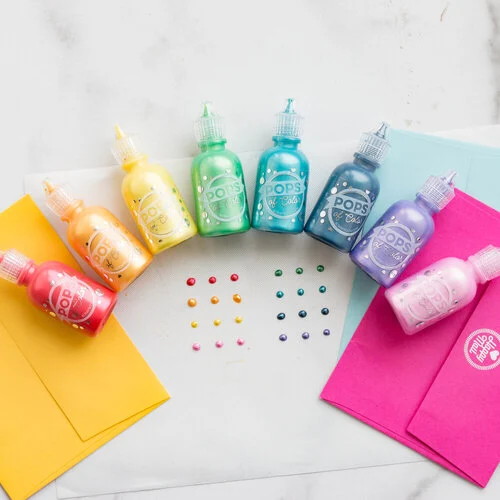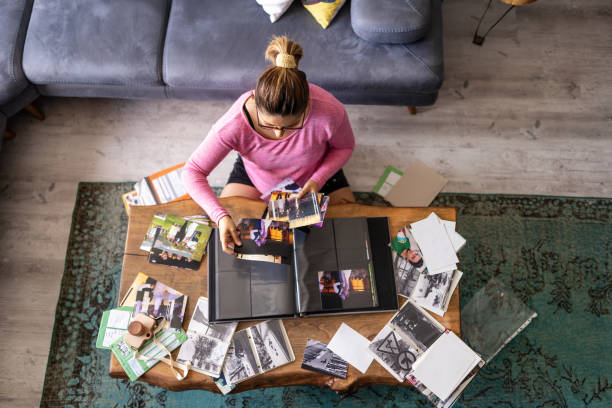
Scrapbooking is a method of preserving, presenting, and arranging personal and family history in the form of a book, box, or card. Typical memorabilia include photographs, printed media, and artwork. Scrapbook albums are often decorated and frequently contain extensive journal entries or written descriptions. Scrapbooking started in the United Kingdom in the nineteenth century.
Discover the joys and mental health benefits of reconnecting with analog activities, such as scrapbooking, in a digital world. Learn how unplugging can enhance creativity, mindfulness, and connection.
In the 15th century, commonplace books, popular in England, emerged as a way to compile information that included recipes, quotations, letters, poems, and more. Each commonplace book was unique to its creator’s particular interests. Friendship albums became popular in the 16th century. These albums were used much like modern day yearbooks, where friends or patrons would enter their names, titles and short texts or illustrations at the request of the album’s owner. These albums were often created as souvenirs of European tours and would contain local memorabilia including coats of arms or works of art commissioned by local artisans.
Introduction: Rediscovering the Joy of the Analog World
In a world where everything is rapidly moving toward digitalization, it’s easy to forget the quiet, grounding power of the analog. From social media scrolling to email bombardment, our days are filled with screens, notifications, and the constant hum of digital interaction. But every so often, a shift happens—a return to simpler pleasures. One of the most rewarding ways to reconnect with the world around you is through analog activities, such as scrapbooking.
Scrapbooking, a beloved hobby for many, is more than just pasting pictures into a book; it’s about capturing memories, expressing creativity, and slowing down to savor moments. With scrapbooking, the process of making something tangible allows us to step away from the noise of technology and immerse ourselves in an activity that brings joy, reflection, and connection.
This article will explore the numerous benefits of returning to analog activities like scrapbooking, and how they can nurture your creativity, mental well-being, and relationships in a digital age.
The Escape of Analog: A Refuge from the Digital Storm

The constant bombardment of information and the ceaseless pinging of digital devices can create a feeling of burnout. Yet, while digital tools are incredibly convenient, they often leave us feeling more fragmented than whole. In contrast, analog activities like scrapbooking offer an opportunity to retreat from the overstimulation of modern life and reconnect with ourselves.
Scrapbooking is one of those activities that requires us to be fully present. There’s no screen, no notifications, no distractions. You have to be in the moment, with your thoughts, your memories, and your materials. This kind of analog experience creates an intentional space for mindfulness—an antidote to the digital noise that often surrounds us.
Scrapbooking: A Creative Outlet for Personal Expression
One of the most significant benefits of scrapbooking is its ability to foster creativity. When we scrap, we blend photos, colors, textures, and journaling into something uniquely personal. The creativity involved in designing layouts, choosing materials, and organizing memories offers us a chance to express ourselves in ways that are deeply fulfilling.
Scrapbooking also invites us to get our hands dirty—literally. Unlike digital activities that can often be done with minimal physical interaction, scrapbooking requires tactile engagement. The act of cutting paper, arranging photos, and gluing materials together helps to ground us and encourages a more personal connection with our work. This tactile process can bring an immense sense of satisfaction and accomplishment.
Through scrapbooking, we reconnect with our creativity, the parts of ourselves that may have been buried under deadlines, email chains, and other digital distractions. Whether you are a seasoned scrapbooker or a beginner, the freedom to experiment and express your emotions through visuals is both therapeutic and empowering.
Memory Preservation and Reflection Through Scrapbooking
Another powerful aspect of scrapbooking is its role in preserving memories. In a world where digital photos are often stored away on hard drives or cloud storage, scrapbookers take a more intentional approach to remembering their lives. Scrapbooking invites us to revisit and reflect on meaningful moments—from family vacations to milestone events to everyday joys—and celebrate them in a physical form.
By gathering and arranging photos, mementos, and written memories, we create something lasting—a tangible storybook of our lives. This process encourages mindfulness, as we pause to think about the significance of the memories we are preserving. It’s a time to relive experiences, savor details we might have forgotten, and appreciate the richness of our lives.
Scrapbooking can also serve as a powerful emotional release. As we reflect on past moments, we may find ourselves processing unresolved feelings or experiencing a deeper understanding of our personal growth. The act of recording these emotions on paper and in pictures helps us better understand our past, enrich our present, and connect to our future.
Mindfulness and Mental Health Benefits
In a world where anxiety and stress are common struggles, reconnecting with analog activities like scrapbooking can have significant mental health benefits. The process of scrapbooking offers an escape from the constant connectivity of the digital world. It helps us slow down, find calm, and practice mindfulness. Mindfulness is the act of being fully aware of the present moment without judgment, and scrapbooking provides the perfect environment to cultivate this.
When we focus on arranging photos, selecting embellishments, and reflecting on memories, we are creating a space where our minds can rest. There’s no pressure to check email, respond to messages, or multitask. The mind can simply focus on the creative process, which has been shown to reduce stress, improve mood, and foster a greater sense of well-being.
By embracing analog activities like scrapbooking, we engage in a form of self-care. We create space to nurture our mental health and encourage positive emotions. It’s a quiet, peaceful way to combat the digital fatigue that so many of us experience.
Strengthening Relationships and Building Connection
Scrapbooking is not just an individual pursuit; it can also be a shared experience that brings people together. For many, scrapbooking is a family tradition—a way to bond over shared memories and create something meaningful together. From collaborative projects to reminiscing about old photos, scrapbooking strengthens relationships by creating opportunities for connection.
When we scrapbook with others, we engage in a collaborative form of creativity. This shared experience deepens emotional bonds and fosters mutual understanding. It also offers a wonderful way to pass down family history. The stories we tell while scrapbooking—about family traditions, travel adventures, or childhood memories—can create a sense of continuity and legacy for younger generations.
In addition, scrapbooking encourages storytelling. By adding written descriptions and captions to photographs, we narrate the story of our lives. This act of storytelling, combined with the physical process of crafting, allows us to connect not only with our past but also with the people around us.
The Joy of Unplugging and Slowing Down
In today’s fast-paced world, we often feel like we must keep up with everything happening around us. But scrapbooking teaches us the beauty of slowing down and embracing simplicity. It’s a process that encourages patience and deliberation, rather than rushing through tasks. When we take the time to carefully choose photos, select materials, and reflect on our memories, we are giving ourselves permission to enjoy the process without haste.
The joy of scrapbooking lies in the journey, not just the final product. It’s about being present with each cut, each glue stick, and each photo you choose to incorporate. This slower pace of creativity invites a deeper connection to the moment and a greater appreciation for the little things in life.
Conclusion: Reconnect With Yourself Through Scrapbooking
In a world that often feels overwhelmed by digital demands, scrapbooking offers an analog sanctuary. It allows us to disconnect from screens and reconnect with our creativity, memories, and mental well-being. Through this process, we gain a renewed appreciation for the tangible, the tactile, and the personal aspects of life.
Scrapbooking not only nurtures our mental health but also strengthens relationships, preserves memories, and encourages mindfulness. Whether done alone or with others, it’s an activity that promotes relaxation, reflection, and personal growth. In rediscovering the joy of analog activities like scrapbooking, we make space for deeper connection—with ourselves, with our memories, and with the people we care about.
So, if you’re looking for a meaningful way to slow down, unplug, and reconnect with your creative self, scrapbooking might be the perfect escape. Embrace the analog, and let your creativity and mindfulness flourish.
Q&A: Answering Your Questions About Scrapbooking and Analog Activities
Q: How can scrapbooking benefit my mental health?
A: Scrapbooking encourages mindfulness, creativity, and reflection, which can reduce stress and promote emotional well-being. It offers a way to escape from digital overload and focus on the present moment.
Q: Can I scrapbook if I’m not naturally artistic?
A: Absolutely! Scrapbooking is about expressing your personal memories and creativity, not about perfection. Use simple layouts and focus on capturing meaningful moments, and your creativity will naturally shine through.
Q: How can I get started with scrapbooking?
A: Start with a small project. Gather some of your favorite photos, some decorative paper, and a glue stick. There are plenty of online tutorials and scrapbooking kits to help guide you through the process.
Q: Is scrapbooking a solitary activity, or can it be done with others?
A: Scrapbooking can be both. You can enjoy it on your own, focusing on personal reflection, or invite family and friends to create shared albums and memories together.
Q: What’s the best way to preserve my completed scrapbook?
A: Store your scrapbook in a cool, dry place away from direct sunlight. Consider using acid-free materials to ensure your photos and pages stay intact for years to come.